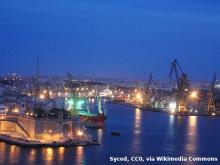
The course on Harbour Engineering focuses on design of harbors and coast management. The part of course that I am teaching counts 32 hours of lectures. The teacher will make extensive use of interactivity, with the options illustrated below.
Lectures include about 6 hours dedicated to solving exercises by using the personal computer, by collaborative work by students and teacher. Students will be kindly asked to bring their own personal computer to solve the exercises. Students are kindly advised to speak with me if bringing their own personal computer turns out to be not possible.
The purpose of the course is to provide an overview of techniques for the design of harbors as well as preserving and recovering beaches and the shoreline in the presence of human impact. The target of the course is to learn how to design harbors and manage beach and shoreline infrastructures. The impact of climate change will be discussed as well as techniques for increasing the resilience of ecosytems.
Interactive learning
The course aims to promote teaching methods based on the active participation by students by using innovative technologies and social media. A fundamental role is played by the interaction between students and teachers. The project aims to integrate the traditional one-way flow of knowledge from teacher to student with a feedback flow from student to teacher and a cross flow among students. The target is achieved by assigning an active role to the student during his/her education. Innovative teaching methods may include:
- Short presentations by students;
- Groups Question&Answers sessions "Challenge the teacher";
- Self evaluation by students;
Tutorial documents
The tutorials for the course will be delivered in the form of open web pages, open media and freely accessible videos of all the lectures, for the sake of developing academic education through fully open information. Tutorials will be updated while teaching through collaborative work with the students (see below).
Tutorial web pages for the lectures (provisional list):
- Harbor Engineering - The learning process adopted in the course
- Coast management and beach design - Premise
- Port planning and environmental impact
- Forcing estimation for harbor design
- Harbor oscillations
- Climate change
- Beach protection strategies and structures
- Design of groins
- Stability of rock and concrete armour units
- Dredging in harbour basins
- Design of breakwaters
Tutorial web pages for the practical exercises (provisional list):
- Short introduction to R and R Studio
- Computation of wind actions on a moored ship and computation of mooring forces.
- Assessment of stability of armour units. Example of excel file for the solution.
Additional information are available on the official Moodle platform of the University of Bologna at this page, that is accessible with student's credentials. Please contact the teacher if you do not have access to this page.
Videos of the lectures
The videos of the lectures are available at the link below:
Playlist of Harbor Engineering 2024
Videos will be made available within one week after the lecture.
Calendar of the lectures
The calendar of the lectures is given here below. Please note that changes may occur. Any change will be communicated by the teacher to the students one week earlier at the latest. If the schedule is not significantly altered the course will terminate around the end of April with a possible extension in May. Lectures are delivered in Ravenna, Via Tombesi dell'Ova.
- Feb 21, 4 hours
- Feb 28, 4 hours
- March 6, 4 hours
- March 13, 4 hours
- March 20, 4 hours
- March 27, 4 hours
- April 3, 4 hours
- April 10, 4 hours
Lectures time will be 13:00 - 16.25 with 25 minutes break at 14:30-14:55.
Exam
Learning outcome will be assessed through an oral examination. The exam typically lasts for about 20-30 minutes and is articulated through 3-4 questions. The teacher may require to provide written response to one question and may ask to develop simple exercises in written form, involving simple calculations. One question aims to assess the ability of the student to deliver a clear and well articulated presentation (this question could be addressed with an interactive activity). Questions are related to the topics that are taught during the lectures and are described in the supporting documents. The teacher may ask questions not directly related to what has been discussed during the lecture in order to assess outstanding capabilities of the student to integrate the notions delivered by the teacher.
The highest score (30/30) is reserved to students who demonstrate a full knowledge of the notions, a very good ability to address questions through an efficient synthesis, and a very good presentation. The laude is reserved to students who demonstrate exceptional motivation and integrate the course content with additional notions by following their personal interest and attitude.
Exam dates will be fixed in agreement with the students at the beginning of the course. Exam dates will be scheduled in June, July, September and January.
Contact details of the teacher and individual clarifications
The teacher is available to provide clarifications on request, by receiving individual students or groups. Teacher can be contacted by email and will receive students after the lectures.
- 347 viste
